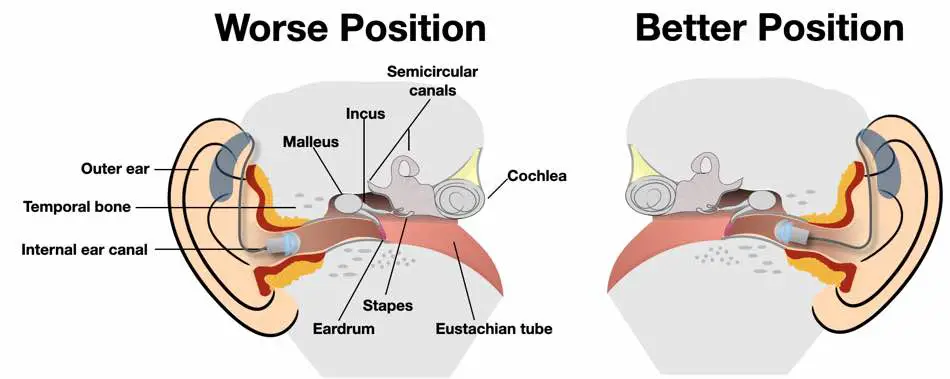If you wonder how far hearing aids should go in your ear you found the right article. Here you will see what may change when the hearing aid is placed more in the outer part of the ear compared to a fitting very deep in the ear canal.
Every ear canal is different in regards to size and shape. This means hearing aids will also be placed differently depending on the wearer. Some people need a bigger earpiece while others just have a receiver with a silicone tip in their ears. But despite those differences, there are some general rules which help you to find the optimal position for your hearing aids in the ear.
- The closer you place the hearing aid tto your eardrum (deeper) the more natural your own voice becomes.
- There is a place which feels most comfortable when the hearing aid is placed in the ear this can mean it sits a little more or less deep.
First of all, you can read an explanation about why a deeper position is better in most cases. First of all the receiver/loudspeaker sit closer to your eardrum which oftentimes makes them sound better. Second, when the earpiece sits behind your lower jar (which is very close to the ear canal) the sound of your voice becomes more natural. In combination with less material covering the outer part of the ear, the fitting feels better. The ears feel less clogged up.
Not everyone likes the hearing aids sitting as deep in the ear canal. In such a case it is a good idea to test if it feels better to push the hearing aid less far into the ear canal. Even small changes like pulling it just a bit more out can make a huge difference here. Especially with hearing aids with standardized shapes like the Signia Silk.

Here in the illustration above you can see the different positions of the loudspeaker in the ear. With the hearing aid positioned deeper in the ear canal which you can see on the right the sound and perception of your own voice will be better. The reason for this is the occlusion effect. When this effect is perceived the lower jar vibrates slightly while you speak.
The vibrations of your own voice remain in the ear. Instead of escaping from the ear, the vibrations bounce off the hearing aid and remain in the ear, making the voice seem louder. In low frequencies, the voice can be amplified by up to 20 decibels.
Can You Push a Hearing Aid in Too Far?
You can push a hearing aid in too far. In such a case it hurts. When you buy hearing aids your hearing aid professional will instruct you on how deep the hearing aids should be placed optimally. The ear canals usually get smaller the deeper you look into it. But in some cases, the ear canals can be so big you could touch the eardrum with a hearing aid. That would hurt. In such a case it is advised to stop the insertion of a hearing aid and talk to your hearing care professional about the problem.
This is very seldom the case as the professional validates the fitting of a hearing aid during the visit to the shop. But what is common when it is pushed too far is unnecessary pressure that builds up due to squeezed areas of the ear canal.
When this happens the fit can be improved by your acoustician optimizing the custom earpiece with slight changes of the shape. Another way to make sure the hearing aid can not be pushed too far into the ear is by switching from a silicone dome to a custom earmold.
When a little silicone dome is pushed into the ear canal the dome changes its form and can then end in a position that is deeper as intended by the hearing care professional. But when a custom earmold is made the earpiece is already shaped after your ear. This way the hearing aid can not be pushed too far anymore as with a little dome.
Is There a Hearing Aid That Does Not Go Into the Ear?
Hearing aids that do not go into your ear work with vibration. The actual hearing aid is positioned on the bone directly behind your ear. This type of hearing aid uses bone conduction in order to transmit the soundwaves although it is not placed in your ear canal.
Those hearing aids oftentimes get mounted on the temple of glasses or are integrated with a headband. First of all this system does not work with every hearing loss. The hearing module is technically and optically integrated into your glasses in such a way that the additional benefit of your glasses is almost invisible. Due to the usual position of the glasses on the head, your hearing system is automatically ideally positioned on the head.
Manufacturers making those hearing aids that do not go into the ear are rarer compared to the ones making normal hearing aids. One of the specialized companies in this space is Bruckhoff. They also have a hearing system that does not need to be specifically made only for one of your glasses but you can click it on several of them which makes the system very versatile.
Compared to the normal hearing aids described above this system has a smaller frequency bandwidth which ranges from 200 – 5000 (Hz) while normal hearing aids provide a frequency bandwidth of 200 – 8000 (Hz) in most cases.
